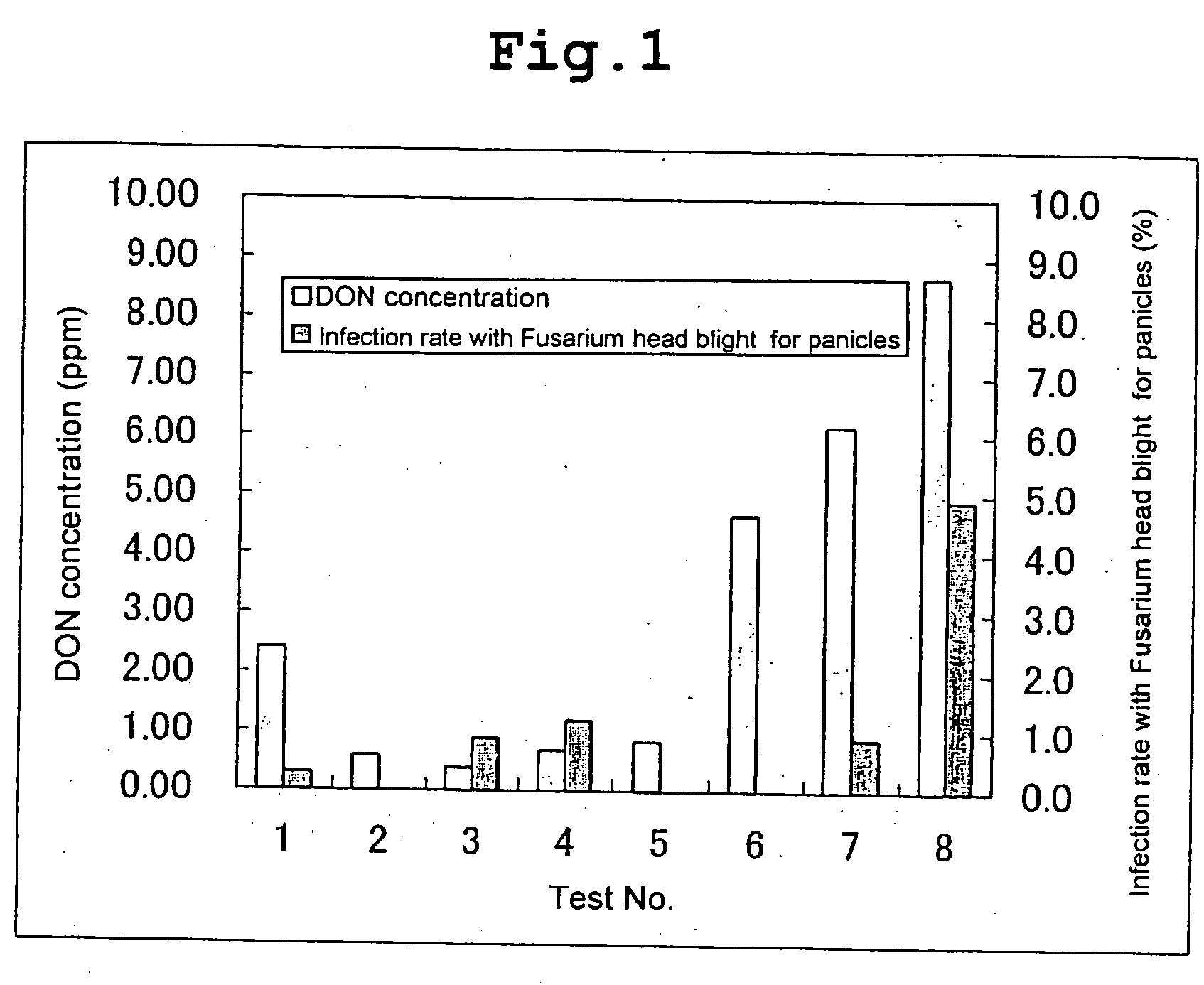Method for preventing wheat from mycotoxin contamination
a technology of mycotoxin and wheat, applied in the field of treatment methods, can solve the problems of affecting the yield of cereals, affecting the quality of cereals, and posing a risk of human ingestion, and achieve the effect of reducing the contamination amount of mycotoxin
- Summary
- Abstract
- Description
- Claims
- Application Information
AI Technical Summary
Problems solved by technology
Method used
Image
Examples
example 1
Single Use (± Conventional Control) Effect
[0018] Wheat (cultivar: Haruyutaka) was seeded on Apr. 19, 2002, and cultivated according to a conventional cultivating standard (Hokkaido, Agriculture Department, 1995) to establish test sections with 6.75 m2 per section (3 repeats). As the compounds A, potassium phosphite and an aluminium salt (generic name: fosetyl) of tris(ethylphosphonate) were given, water solution of 0.038 to 0.120% in P2O5 was prepared, and 100 L per 10 a was sprayed on leaves at next growth stage. That is, the first spray (June 28, flowering date), the second spray (July 8, 10 days after the flowering date, and the third spray (July 18, 20 days after the flowering date) were performed. A conventional control for the purpose of controlling plant pathogens and plant insects was performed together. That is, the first [June 20, azoxystrobin (2000 times dilution)+fenitrothion (1000 times dilution)], the second [tebuconazol (June 28, 2000 times dilution)+sumithione (1000...
example 2
Toxin-Inhibitory Effect by Seeds Diseased with Fusarium Head Blight in Example 1
[0027] Healthy grains and grains diseased with Fusarium head blight were screened from the crude wheat obtained in Example 1, and the DON contamination concentration of the whole grain powder thereof was analyzed by the ELISA method in the same way as shown in Example 1.
[0028] The results of the present test are shown in Table 2.
TABLE 2DON contamination concentration of grainsdiseased with Fusarium head blightDON concentrationTreatment content(ppm)ActiveConcen-Controlhealthydiseasedingredient Atrationsystemgraingrain1Potassium0.038%Conventional0.0576.6phosphitecontrol20.070%Conventional0.0444.7control30.112%Conventional0.0425.4control4No control0.0475.65Fosetyl0.120%Conventional0.9611.0control6Potassium0.112%Conventional0.0686.9phosphatecontrol7Conventional1.7290.0control8No control0.73173.0
Note)
The concentration of the active ingredient A is the concentration converted into P2O5.
Note)
The grains c...
example 3
Mixed Use (1)
[0030] Wheat (cultivar: Haruyutaka) was seeded on Apr. 23, 2002, and cultivated according to a conventional cultivating standard (Hokkaido, Agriculture Department, 1995) to establish test sections with 10 m2 per section (3 repeats). A suspension containing potassium phosphite and various fungicidal agents was prepared in a liquid mixture made up of a spreading agent (Gramine S: supplied from Hokkai Sankyo Co., Ltd.) and water. Using potassium phosphite as the compound A, 0.070% P2O5, and the 0.006 to 0.025% fungicidal agent for agri-horticulture for the wheat as the compound B, water solution containing them was prepared, and 100 L thereof per 10 a was sprayed on leaves in the following growth stages. That is, the first spray (June 24, heading date), the second (June 30, flowering stage), the third (July 9) were performed. The harvest was performed on August 12 (50 days after the heading date) by harvesting the wheat in 3.4 m2 in each section. After the harvest, the wh...
PUM
 Login to View More
Login to View More Abstract
Description
Claims
Application Information
 Login to View More
Login to View More - R&D
- Intellectual Property
- Life Sciences
- Materials
- Tech Scout
- Unparalleled Data Quality
- Higher Quality Content
- 60% Fewer Hallucinations
Browse by: Latest US Patents, China's latest patents, Technical Efficacy Thesaurus, Application Domain, Technology Topic, Popular Technical Reports.
© 2025 PatSnap. All rights reserved.Legal|Privacy policy|Modern Slavery Act Transparency Statement|Sitemap|About US| Contact US: help@patsnap.com


